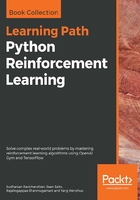
Computation graph
Everything in TensorFlow will be represented as a computational graph that consists of nodes and edges, where nodes are the mathematical operations, say addition, multiplication and so on, and edges are the tensors. Having a computational graph is very efficient in optimizing resources and it also promotes distributed computing.
Say we have node B, whose input is dependent on the output of node A; this type of dependency is called direct dependency.
For example:
A = tf.multiply(8,5)
B = tf.multiply(A,1)
When node B doesn't depend on node A for its input it is called indirect dependency.
For example:
A = tf.multiply(8,5)
B = tf.multiply(4,3)
So if we can understand these dependencies, we can distribute the independent computations in the available resources and reduce the computation time.
Whenever we import TensorFlow, a default graph will be created automatically and all nodes we create will get associated with the default graph.